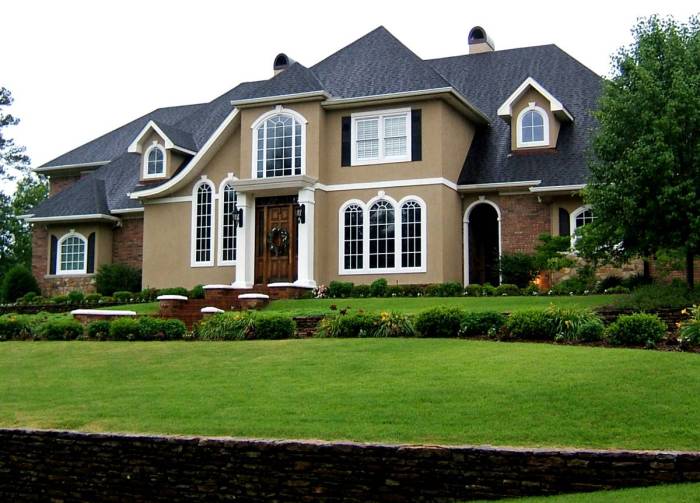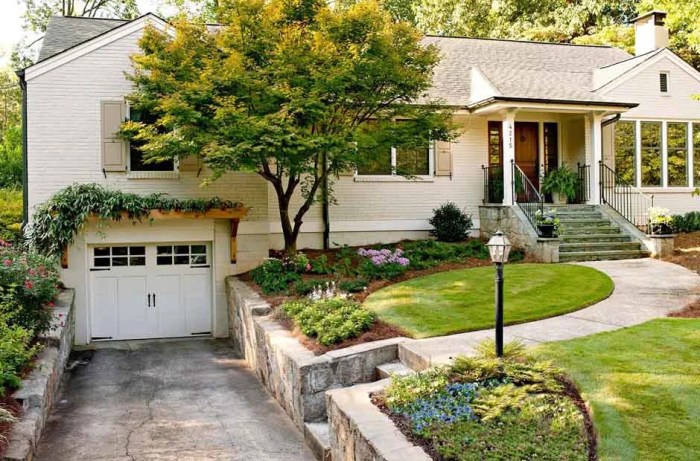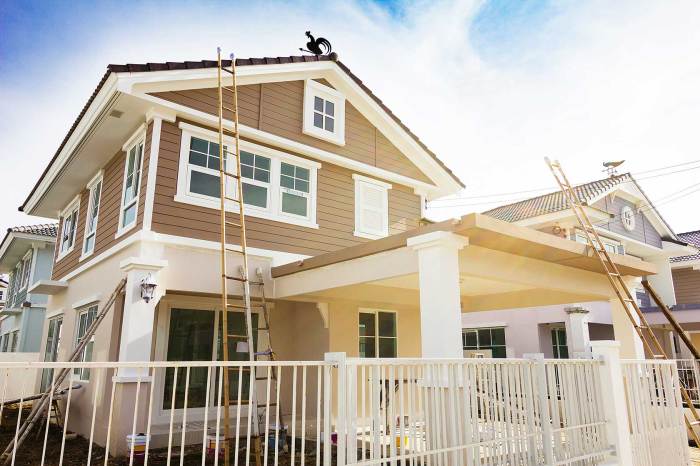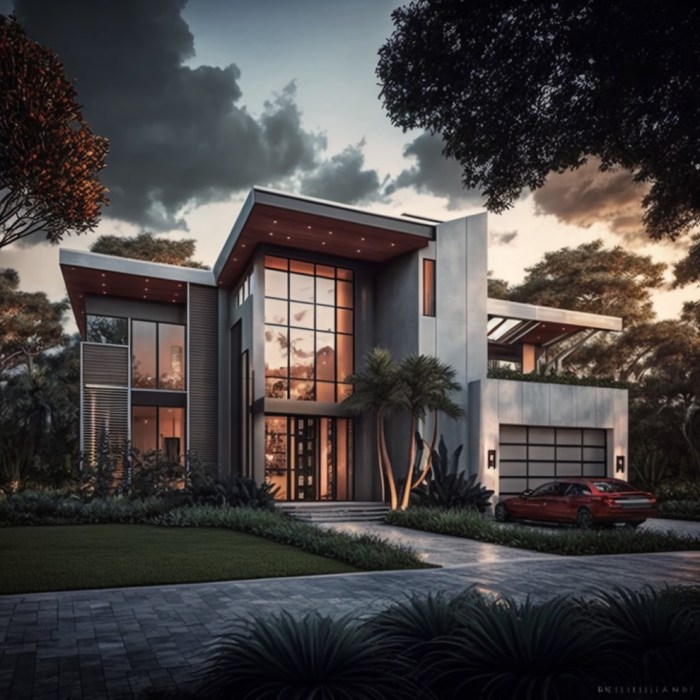DIY Exterior Renovation Guide Your Home Improvement Handbook
DIY exterior renovation guide provides a comprehensive approach to transforming your home’s exterior. From simple painting projects to major overhauls like siding replacement or deck construction, this guide equips you with the knowledge and strategies to tackle any exterior renovation task successfully. We’ll explore the benefits and challenges of DIY projects, comparing them to professional options, and walk you through the crucial planning, execution, and maintenance phases.
The guide is structured into manageable sections, covering everything from essential planning and budgeting to safety precautions and long-term care. Each section includes detailed explanations, helpful checklists, and practical advice. Whether you’re a seasoned DIY enthusiast or a complete novice, this guide will empower you to undertake your exterior renovation project with confidence and success.
Introduction to DIY Exterior Renovation: DIY Exterior Renovation Guide
DIY exterior renovations offer homeowners the opportunity to personalize their properties and potentially save money. However, these projects can be complex and require significant time and effort. Careful planning and a realistic assessment of skills are crucial for successful outcomes.
Exterior renovations encompass a wide range of projects, from simple touch-ups to substantial overhauls. Understanding the various options and associated challenges is essential for homeowners considering DIY projects. A thorough understanding of the scope of work, the time commitment, and the necessary skills is vital for a positive experience.
Different Types of Exterior Renovations
Various exterior renovations can enhance a home’s aesthetic and functionality. These projects range from cosmetic upgrades to structural improvements.
- Painting:
- Siding Replacement:
- Roof Repair:
- Deck Construction:
- Window Replacement:
A relatively straightforward project, painting can dramatically alter a home’s appearance. Proper preparation, including surface cleaning and priming, is key to achieving a long-lasting and professional finish. Different paint types have different properties and applications. Choosing the right paint for the specific surface is essential.
Replacing siding is a more involved project, often requiring significant time and physical effort. The process involves removing the old siding, preparing the surface, and installing new siding. Choosing the right siding material is important for durability and aesthetics.
Roof repair projects vary widely in complexity, from minor repairs to complete replacements. Damaged shingles, leaks, or missing tiles require careful attention. Roof repairs should be addressed promptly to prevent further damage and water intrusion.
Building a deck can add substantial value and outdoor living space to a home. This project involves planning the deck layout, obtaining permits, and selecting the right materials. Proper structural support and safety considerations are paramount.
Replacing windows can significantly improve energy efficiency and curb appeal. The project involves removing old windows, preparing the openings, and installing new windows. Choosing energy-efficient windows can reduce heating and cooling costs.
DIY vs. Professional Exterior Renovations
Homeowners should weigh the pros and cons of DIY versus professional renovations carefully. Both options have distinct advantages and disadvantages.
- Cost Comparison:
- Time Estimates:
Professional renovations typically involve higher upfront costs due to labor fees. DIY renovations can save money on labor, but materials and potential mistakes can increase overall costs. Detailed cost breakdowns for each project are essential. A comparative analysis of DIY versus professional costs should factor in the potential for unexpected expenses. For instance, a seemingly inexpensive painting project could escalate if the prep work is extensive.
DIY renovations often take longer to complete due to the time needed for learning, planning, and execution. Professional renovations can be faster, especially for complex projects. Estimating the time required for each project stage is crucial for realistic scheduling. For example, a roof repair may take less time if the damage is localized and if the homeowner has the necessary tools and experience.
Project Comparison Table
The following table provides a general comparison of various exterior renovation projects, including estimated costs, timeframes, and skill levels required.
| Project | Estimated Cost (USD) | Estimated Time (Days) | Skill Level Required |
|---|---|---|---|
| Painting (small exterior wall) | $300-$1000 | 1-3 | Beginner |
| Siding Replacement (small section) | $1500-$5000 | 3-7 | Intermediate |
| Roof Repair (minor leak) | $500-$2000 | 2-5 | Intermediate |
| Deck Construction (small deck) | $2000-$8000 | 5-10 | Intermediate to Advanced |
| Window Replacement (2 windows) | $500-$2000 | 1-3 | Beginner to Intermediate |
Planning and Preparation
A well-planned exterior renovation project significantly impacts the success and cost-effectiveness of the entire undertaking. Careful preparation ensures that the renovation proceeds smoothly, minimizes unexpected issues, and ultimately results in a satisfying outcome. Thorough planning allows for a clearer understanding of the scope of work, potential challenges, and required resources.
A comprehensive plan acts as a roadmap, guiding every step of the project from initial assessment to final execution. This roadmap ensures that the renovation aligns with the homeowner’s vision and budget. Proper planning also helps to identify potential problems early on, allowing for proactive solutions and cost savings.
Assessing the Current Condition
A crucial first step in any exterior renovation is a thorough assessment of the existing structure’s condition. This involves inspecting the foundation, walls, roofing, siding, and other components. Visual inspections should be supplemented by professional assessments where necessary, especially for structural elements. Detailed documentation, such as photographs and written notes, should be created to record the current state of the property. This detailed record will prove invaluable for tracking progress and identifying any changes during the project.
Gathering Measurements and Creating Blueprints
Accurate measurements are essential for creating precise blueprints and ordering materials. Use a measuring tape and level to accurately record dimensions, window and door locations, and existing structures. Consider using a laser measuring tool for increased efficiency and accuracy. These measurements will serve as the foundation for constructing accurate blueprints or sketches, which will help in planning material needs, labor estimates, and potential design modifications. These blueprints are critical for contractors and DIYers alike to have a clear vision of the project.
Essential Tools, Materials, and Safety Equipment
Proper planning includes assembling the necessary tools, materials, and safety equipment. This meticulous preparation reduces risks and enhances efficiency. A comprehensive checklist should include essential tools like hammers, screwdrivers, saws, and measuring equipment. Materials needed should be carefully evaluated based on the project’s scope. Essential safety equipment, including safety glasses, gloves, and hard hats, must be prioritized for a safe work environment.
Potential Problems and Solutions
Renovation projects often encounter unexpected issues. Addressing potential problems proactively helps in avoiding costly delays and complications. Here’s a brief overview of potential issues for various renovation types:
- Siding Replacement: Issues like improper installation, material damage, and water leaks can occur. Addressing these issues proactively, through thorough inspection, precise measurements, and hiring a skilled contractor, can prevent costly repairs and delays.
- Roofing Repair: Problems such as leaks, missing shingles, and damaged flashing can arise. Solutions include careful inspection, professional assessments, and using appropriate materials for the specific type of roof and environment.
- Foundation Repair: Cracks, settling, and water damage can impact the foundation. Professional inspection and repair are crucial to prevent structural issues. These issues can be costly, and often require specialized contractors.
Renovation Materials and Properties
Choosing the right materials is essential for long-term durability and cost-effectiveness. A comparative analysis of different materials is presented below:
| Material | Durability | Cost | Maintenance |
|---|---|---|---|
| Vinyl Siding | High | Moderate | Low |
| Wood Siding | Medium | High | Medium |
| Fiber Cement Siding | High | High | Low |
| Metal Siding | Very High | High | Low |
Note: Costs and maintenance levels are relative and can vary based on specific materials, installation, and environmental factors.
Specific Renovation Projects
Exterior renovations can significantly enhance your home’s curb appeal and value. Proper planning and execution are crucial for successful projects. Understanding the various steps involved in each project, from painting to deck building, is key to a smooth and rewarding experience.
Exterior Wall Painting
Exterior wall painting is a common and relatively straightforward renovation project. Thorough preparation is essential to achieve a lasting and aesthetically pleasing result. Preparing the surface involves cleaning the walls, repairing any cracks or damage, and removing loose paint. Priming the walls is critical for better paint adhesion and a more even finish. High-quality exterior paints are specifically formulated to withstand the elements, increasing the longevity of the project. Choosing the right paint type and color for your home’s architectural style is also important. Various painting techniques, such as using a brush, roller, or spray gun, can be employed based on the size and complexity of the project.
Exterior Siding Replacement
Replacing exterior siding can dramatically transform your home’s appearance and increase its energy efficiency. Selecting the right material for your home is crucial. Options range from traditional wood siding to more modern vinyl or fiber cement. Each material has its unique properties and maintenance requirements. Installation procedures vary based on the type of siding chosen. Properly fitted and secured siding is critical for structural integrity and weather protection. Detailed instructions and considerations for various siding types are available from reputable manufacturers and home improvement retailers.
Roof Repair or Replacement
Roof repair or replacement is a significant exterior renovation project. Safety is paramount during all roofing work. Using appropriate safety equipment and adhering to professional guidelines is crucial. Common roofing issues include damaged shingles, missing shingles, and leaks. Identifying and addressing these issues early can prevent further damage and costly repairs. Choosing the right roofing materials and ensuring proper installation are essential for a durable and long-lasting roof. Working with a qualified contractor can help determine the most suitable approach for your specific situation.
Deck Construction
Building a deck can significantly expand your outdoor living space. A well-designed deck adds significant value to a home. Before construction, proper planning and design are vital. Consider factors such as the location, size, and structural requirements of your deck. Ensuring the deck is built to meet local building codes and safety standards is essential. Choosing the right materials for your deck, including the deck boards, railings, and posts, is critical for durability and aesthetics. Proper sealing and waterproofing measures are essential to prevent moisture damage and extend the life of the deck.
Exterior Sealing and Waterproofing
Proper sealing and waterproofing of exterior surfaces is vital for preventing water damage, which can lead to costly repairs. Various techniques are available for sealing and waterproofing different surfaces, including concrete, brick, and wood. Choosing the right sealant or waterproofing material is crucial for achieving a long-lasting and effective solution. Regular maintenance and inspection are also important to ensure the longevity of your sealing and waterproofing measures. Using appropriate techniques for different exterior materials, including concrete, wood, or brick, is crucial.
Common Mistakes in DIY Exterior Renovations
Common mistakes in DIY exterior renovations often stem from overlooking crucial details. Failing to adequately prepare surfaces before painting can result in uneven or peeling paint. Poorly installed siding can compromise the structural integrity of the home. Ignoring safety precautions during roofing work can lead to injuries. Inadequate waterproofing can lead to costly water damage. Proper research, planning, and adherence to instructions can mitigate these risks.
Common Exterior Renovation Issues and Solutions
| Issue | Solution |
|---|---|
| Peeling paint | Proper surface preparation, using the correct primer, and selecting suitable paint. |
| Sagging or damaged siding | Thorough inspection, appropriate material selection, and careful installation procedures. |
| Roof leaks | Identifying and repairing the source of the leak, replacing damaged shingles or flashing, and ensuring proper drainage. |
| Water damage to decks or foundations | Implementing proper sealing and waterproofing measures, ensuring proper drainage, and addressing any structural issues. |
Budgeting and Cost Management
Exterior renovations can be exciting but also costly. A well-defined budget is crucial for managing expectations and ensuring the project stays on track. Careful planning and realistic estimations of material and labor costs will help prevent unpleasant surprises down the road.
A thorough budget anticipates not just the obvious expenses, but also potential contingencies. This proactive approach allows for flexibility and a more controlled renovation experience. Properly allocating funds for materials, labor, permits, and potential unforeseen issues is essential for a successful project.
Creating a Realistic Budget
A realistic budget starts with careful assessment of the scope of work. Detailed plans and precise measurements are fundamental for accurate material calculations. Don’t underestimate the importance of contingency funds to address unforeseen circumstances. Consider the potential for price fluctuations in materials and labor during the project timeline. For example, a sudden increase in lumber prices could significantly impact the overall cost. Using online calculators and consulting with contractors can provide helpful estimates.
Material Costs
Materials represent a significant portion of the renovation budget. Precisely measuring the area to be covered is essential for accurate material calculations. For example, if you’re replacing siding, calculating the square footage accurately will help you avoid over-ordering or under-ordering. Consider the quality of materials; higher-quality options might have a higher upfront cost but could offer longer-lasting value and require less future maintenance. Shopping around for materials from various suppliers and comparing prices can yield substantial savings.
Labor Costs, DIY exterior renovation guide
Labor costs vary based on the complexity of the work and the location. Hiring reputable contractors is vital. Get multiple quotes from different contractors, comparing not just the price but also their experience and reputation. Detailed estimates should clearly Artikel the tasks and the hourly or project rates involved.
Permit Costs
Permits are necessary for legal compliance and often include fees for processing. These fees can vary significantly depending on the jurisdiction and the scope of the renovation. Be sure to research the specific permit requirements in your area. Obtain quotes for permit costs from the relevant authorities. Examples of permit requirements may include a building permit, plumbing permits, and electrical permits.
Ways to Save Money
Exploring cost-effective alternatives for materials and labor can significantly impact the overall budget. Consider using less expensive, but equally effective, materials where appropriate. For example, using composite siding instead of wood siding can be more budget-friendly and less prone to maintenance. Consider hiring subcontractors for specific tasks, such as painting or landscaping, if this is a viable option to save on labor costs. Look for sales and discounts on materials to reduce the overall cost.
Securing Financing
Several options are available for financing exterior renovations. Home equity loans, lines of credit, and personal loans can provide the necessary funds. Evaluate your creditworthiness and the interest rates associated with each option. Carefully compare the terms and conditions of different financing options. For example, if you choose a home equity loan, make sure to understand the impact on your home’s equity and potential future refinancing options.
Funding Options
| Funding Option | Description | Pros | Cons |
|---|---|---|---|
| Home Equity Loan | Borrowing against the equity in your home. | Potentially lower interest rates. | Decreases your home equity. |
| Home Equity Line of Credit (HELOC) | Access funds as needed up to a predetermined limit. | Flexibility in borrowing. | Variable interest rates. |
| Personal Loan | Loan from a financial institution based on your creditworthiness. | Simpler application process in some cases. | Potentially higher interest rates. |
| Renovation Loan | Loan specifically designed for home renovations. | Potential for favorable terms. | Might have higher interest rates compared to other loans. |
Obtaining Permits and Inspections
Obtaining necessary permits and inspections is essential for legal compliance. Ensure that all work adheres to local building codes and regulations. These inspections are important for verifying that the renovation is carried out safely and to the required standards. Contact the local building department for specific permit requirements in your area. This step will ensure the project’s legality and safety.
Safety and Legal Considerations
Exterior renovations, while rewarding, can be hazardous if not approached with careful planning and adherence to safety protocols. Proper safety measures and legal awareness are paramount to a successful and incident-free project. Ignoring these aspects can lead to costly mistakes, injuries, or even legal complications.
Thorough understanding of safety precautions, local regulations, and insurance implications is crucial for a smooth and safe renovation process. This section details essential safety measures and legal considerations to protect your well-being, property, and legal standing.
Essential Safety Precautions
Proper safety measures are vital during exterior renovations, particularly when working at heights or handling power tools. Failure to follow these precautions can result in serious injuries or accidents.
- Working at Heights: Utilize appropriate fall protection equipment, such as harnesses and safety nets, when working on roofs, walls, or other elevated surfaces. Proper training and supervision are essential. Always inspect equipment before each use to ensure it is in good working condition.
- Tool Handling: Always follow manufacturer instructions when operating power tools. Ensure proper ventilation and use appropriate personal protective equipment (PPE), such as safety glasses, gloves, and ear protection. Store tools safely to prevent accidents and injuries.
- Material Handling: Employ proper lifting techniques when handling heavy materials. Use dollies, hand trucks, or other appropriate equipment to avoid back injuries. Ensure proper stacking and storage of materials to prevent falls and other accidents.
- Weather Considerations: Be mindful of weather conditions, such as strong winds, rain, or extreme temperatures. Postpone work when conditions are hazardous. Appropriate clothing and gear are crucial in maintaining safety.
Local Building Codes and Regulations
Understanding and complying with local building codes and regulations is critical for ensuring your renovation is both safe and legally compliant. These codes often address safety, structural integrity, and the aesthetic appearance of the finished project.
Local authorities have the legal power to enforce these codes, and non-compliance can lead to fines, delays, or even project shutdowns. Consulting with local authorities is highly recommended to ensure the project is compliant.
Legal Implications of DIY Renovations
DIY renovations, while offering cost savings, come with legal responsibilities. Permits and liability issues are significant considerations.
- Permits: Certain renovations, such as those affecting structural elements or electrical/plumbing systems, require permits from the local building department. Failing to obtain necessary permits can lead to legal problems and project delays.
- Liability: If your DIY renovation causes damage to your property or injuries to others, you could face legal liability. Adequate insurance coverage is essential in mitigating these risks.
Importance of Insurance Coverage
Adequate insurance coverage is crucial for protecting yourself and your property during exterior renovations. Insurance can provide financial protection against potential risks and liabilities.
| Insurance Type | Typical Coverage for DIY Renovations |
|---|---|
| Homeowners Insurance | Generally covers accidental damage to the property during the renovation process. Coverage limits and exclusions may apply. |
| General Liability Insurance | Covers liability for injuries or damages caused to others during the renovation. |
| Commercial Contractors Insurance (if applicable) | Provides broader coverage for professional DIY renovations, including liability, property damage, and worker’s compensation. |
- Specific Coverage: Review your existing homeowner’s insurance policy for details on renovation coverage. Additional coverage may be needed depending on the scope of the project. A separate general liability policy might be necessary to safeguard against potential liabilities.
Safety Measures During Each Step
A systematic approach to safety during each renovation step can help prevent accidents and ensure the project proceeds smoothly.
- Planning and Preparation: Thoroughly plan the renovation, including safety procedures and necessary equipment. Create a detailed checklist for each step.
- Materials Handling: Use appropriate handling techniques to avoid injuries. Store materials safely to prevent falls or other accidents.
- Working at Heights: Ensure proper fall protection is in place and used correctly.
- Tool Usage: Inspect tools before use and follow manufacturer instructions carefully.
- Cleanup: Clean up debris promptly to maintain a safe work environment. Store materials safely to prevent falls.
Tools and Materials
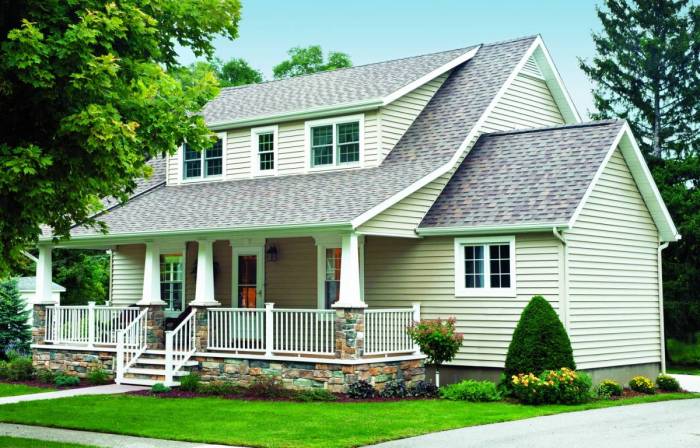
Source: co.uk
Choosing the right tools and materials is crucial for a successful exterior renovation project. Careful consideration of both power and hand tools, as well as the specific materials needed for the job, will save time and money in the long run. This section provides a comprehensive overview of essential tools and materials, along with their appropriate applications.
Exterior renovations encompass a wide range of tasks, from painting and siding replacement to roofing and deck construction. A well-equipped toolkit and selection of high-quality materials are paramount for achieving a durable and aesthetically pleasing outcome.
Essential Tools for Exterior Renovations
Selecting the correct tools is as important as the materials themselves. Having the right tools ensures efficiency and reduces the risk of damage to the work area. Improper use of tools can lead to costly mistakes and delays in the project.
- Power Tools: Electric drills, saws (circular, reciprocating, miter), sanders, and power washers are essential for various tasks. Specific tools needed will depend on the renovation scope. For example, a circular saw is necessary for cutting wood, while a power sander is useful for smoothing surfaces.
- Hand Tools: A comprehensive set of hand tools, including hammers, screwdrivers, pliers, levels, and measuring tapes, is indispensable. These tools are essential for precise work and fine details. For instance, a level ensures straight lines, while a screwdriver is crucial for securing fasteners.
- Measuring Devices: Accurate measurements are critical for all exterior renovations. Measuring tapes, levels, squares, and plumb bobs are necessary for precise layout and installation.
Exterior Materials Selection
Choosing the right materials is critical to the longevity and aesthetics of the project. Consider factors such as climate, budget, and desired aesthetic when selecting materials. Using high-quality materials ensures a longer lifespan and reduces the need for future repairs.
- Paints: Exterior paints come in various types, each with specific properties. Acrylic latex paints are popular for their durability and ease of application. Alkyd paints offer superior durability but may require more preparation. Consider the paint’s UV resistance and weather resistance for optimal performance.
- Siding: Different siding materials offer various advantages and disadvantages. Vinyl siding is popular for its low maintenance and affordability. Wood siding offers a natural aesthetic but requires more upkeep. Fiber cement siding provides durability and longevity but is more expensive.
- Roofing Materials: Roofing materials play a crucial role in protecting the home from the elements. Asphalt shingles are a common choice for their affordability. Metal roofing provides excellent longevity but is more expensive. Tile roofing offers a unique aesthetic but comes with a higher price tag.
- Deck Lumber: Deck lumber needs to be treated to resist rot and decay. Pressure-treated lumber is commonly used for its durability. Cedar lumber offers a natural aesthetic but may require more maintenance.
Importance of High-Quality Materials
High-quality materials translate to long-term durability and reduced maintenance costs. Choosing inexpensive options might lead to premature failures and necessitate costly repairs in the future. Consider the potential long-term value when making material choices.
Comparison of Exterior Renovation Materials
| Material | Pros | Cons |
|---|---|---|
| Vinyl Siding | Low maintenance, affordable, durable, various colors and styles | Can be less aesthetically pleasing than other options, may not be as durable in extreme weather conditions. |
| Wood Siding | Natural aesthetic, good insulation | Requires regular maintenance (painting, sealing), susceptible to rot and decay |
| Fiber Cement Siding | High durability, low maintenance, long lifespan, fire-resistant | More expensive than vinyl or wood, may not offer same aesthetic options. |
| Asphalt Shingles | Affordable, readily available, good protection against the elements | Shorter lifespan compared to other roofing materials, potential for leaks |
| Metal Roofing | High durability, long lifespan, excellent resistance to weather, fire-resistant | Higher initial cost, may require specialized installation |
Project Management and Timeline
Successfully managing a DIY exterior renovation hinges on meticulous planning and execution. A well-defined project timeline, coupled with effective project management strategies, significantly increases the likelihood of a smooth and on-budget renovation. Understanding how to break down complex tasks into manageable steps, and effectively allocate time and resources, are crucial components of a successful outcome.
Effective project management for DIY exterior renovations necessitates a proactive approach. This includes meticulous planning, realistic scheduling, and a flexible mindset to adapt to unforeseen challenges. A well-structured timeline, encompassing all phases of the project, acts as a roadmap to guide your efforts and ensure a timely completion.
Effective Project Management Strategies
A crucial aspect of DIY exterior renovation success is implementing effective project management strategies. This involves proactively identifying potential challenges, developing contingency plans, and maintaining open communication throughout the process. Clear communication with any subcontractors or family members involved in the renovation is essential.
- Establish clear communication channels: Establish clear communication protocols with all parties involved, including subcontractors if applicable. This could be daily check-ins, email updates, or a shared project management platform. Ensure everyone understands roles, responsibilities, and expected timelines.
- Develop a detailed project scope: Documenting all tasks and their associated timeframes ensures a comprehensive understanding of the project’s scope. This includes both anticipated and potential issues.
- Create a risk assessment and contingency plan: Anticipate potential issues like weather delays, material shortages, or unforeseen structural problems. Developing contingency plans for each risk will help you remain adaptable and keep the project on track.
- Utilize project management tools: Employ project management tools, such as spreadsheets, apps, or dedicated software, to track progress, manage tasks, and maintain a centralized communication hub.
Time Management Techniques
Time management is critical for staying on schedule and within budget during an exterior renovation. These techniques enable efficient task execution and reduce the likelihood of cost overruns.
- Prioritize tasks: Identify tasks requiring immediate attention and allocate sufficient time. Use methods like the Eisenhower Matrix (urgent/important) to prioritize tasks based on their impact and deadlines.
- Break down large projects into smaller tasks: Dividing large projects into smaller, manageable tasks facilitates better tracking and reduces the feeling of overwhelming complexity.
- Estimate realistic timeframes for each task: Underestimating task durations can lead to delays and frustration. Base your estimations on past experience or research.
- Buffer time for unexpected delays: Building buffer time into your schedule allows for unforeseen issues or unexpected delays, maintaining a smooth workflow.
Task Breakdown and Scheduling
Breaking down large projects into smaller, manageable tasks is essential for efficient project management. Effective scheduling allows for better resource allocation and ensures tasks are completed in a timely manner.
- Detailed task lists: Create a comprehensive list of all tasks, from initial preparation to final cleanup. Categorize tasks by phase to visualize the project’s progression.
- Establish task dependencies: Identify which tasks depend on the completion of others to avoid overlapping or missed steps.
- Assign deadlines to each task: Set realistic deadlines for each task to maintain momentum and keep the project on schedule.
- Utilize task delegation methods: Where applicable, delegate tasks to other family members or professionals. This can accelerate progress and distribute workload effectively.
Step-by-Step Timeline Planning
Planning a timeline for each renovation phase involves meticulous planning. This involves assessing each step and anticipating any delays.
- Initial Assessment: Analyze the current condition of the exterior, identifying specific areas needing attention.
- Research and Planning: Research materials, costs, and potential contractors.
- Material Ordering: Order materials well in advance, considering lead times.
- Project Execution: Begin with preparatory tasks and proceed through each step, adhering to the timeline.
- Quality Control: Regularly assess the quality of work and make necessary adjustments.
- Completion and Cleanup: Finalize the project, clean up the work area, and document the renovation’s progress.
Project Timeline Example
| Phase | Milestone | Deadline |
|---|---|---|
| Preparation | Site preparation, permits secured | Week 1 |
| Framing | Framing completed | Week 2 |
| Siding | Siding installed | Week 3 |
| Windows/Doors | Windows/doors installed | Week 4 |
| Finishes | Painting, trim, final touches | Week 5 |
| Cleanup | Site cleaned, debris removed | Week 6 |
Maintenance and Long-Term Care
Taking care of your newly renovated exterior is crucial for preserving its beauty and longevity. Proper maintenance extends the life of your investment and prevents costly repairs down the road. This section provides practical tips and strategies for keeping your exterior looking its best for years to come.
Regular maintenance is key to avoiding significant problems. Addressing minor issues promptly prevents them from escalating into major repairs, saving you time and money. This proactive approach also enhances the overall aesthetic appeal of your home.
Exterior Cleaning Procedures
Regular cleaning is essential for maintaining the appearance and integrity of your exterior surfaces. This includes removing dirt, grime, and mildew buildup. Proper cleaning methods prevent damage to the surfaces and maintain the effectiveness of protective coatings.
- Washing Surfaces: Use mild detergent and water for most surfaces. For tougher stains, a specialized cleaner might be needed. Always check the manufacturer’s recommendations for the specific materials used in your renovation. A soft-bristled brush or sponge is ideal for scrubbing. Avoid using harsh chemicals or abrasive cleaners, as these can damage the paint or other finishes.
- Roof Cleaning: Roof cleaning should be done with caution, as improper methods can damage shingles or lead to leaks. Use a soft-wash technique with specialized roof cleaning solutions. Consult a professional if you’re unsure about cleaning your roof yourself.
- Window Cleaning: Regular window cleaning prevents streaks and dirt buildup, enhancing the view from your home. Use a squeegee and a mild detergent for effective cleaning. Pay attention to frames and sills as well.
Repairing and Repainting Exterior Surfaces
Regular inspections are vital for catching minor damage early. Addressing these issues quickly prevents them from worsening. Prompt repairs also maintain the structural integrity of your home.
- Paint Touch-ups: Regularly check for chipped or faded paint. Touch up any minor damage to prevent further deterioration. Use matching paint to maintain the original color scheme.
- Wood Repair: Inspect wood surfaces for cracks, splinters, and rot. Apply wood filler or sealant to fix small cracks and holes. For more significant damage, consult a professional carpenter.
- Caulk Repairs: Check for cracks or gaps in caulking around windows, doors, and other exterior features. Re-caulk these areas to prevent water damage and maintain a weather-tight seal.
- Repainting: Assess the condition of the exterior paint every few years. Repainting is crucial for protecting the surface from the elements and maintaining its appearance. Choose high-quality exterior paints that are designed for your specific climate and materials.
Protective Coatings and Sealants
Protective coatings and sealants play a critical role in the long-term maintenance of your exterior. These products provide a barrier against moisture, mildew, and other environmental factors.
- Applying Sealants: Apply sealants to areas prone to water damage, such as around windows, doors, and rooflines. Follow the manufacturer’s instructions for application and drying times.
- Choosing the Right Coatings: Select coatings appropriate for your climate and the materials used in your renovation. This ensures optimal protection and longevity.
Identifying and Addressing Potential Problems
Early identification of potential problems is critical for preventing major issues. This includes recognizing signs of moisture intrusion, pest infestation, and structural damage.
- Regular Inspections: Conduct regular visual inspections of your exterior surfaces. Pay close attention to areas that are susceptible to moisture or pest activity.
- Moisture Detection: Check for signs of moisture intrusion, such as mold, mildew, or water stains. Address these issues promptly to prevent further damage.
- Pest Control: Regularly inspect your home for signs of pest infestation. Take appropriate action to eliminate pests and prevent future infestations.
Maintenance Schedule
A well-defined maintenance schedule helps you stay on top of necessary tasks. This proactive approach prevents costly repairs and ensures your exterior remains in excellent condition.
| Maintenance Task | Frequency |
|---|---|
| Exterior Cleaning | Monthly (or as needed) |
| Paint Touch-ups | Quarterly |
| Wood Repair/Inspection | Biannually |
| Caulk Inspection/Repairs | Annually |
| Protective Coating Application/Inspection | Every 2-3 years |
| Comprehensive Exterior Inspection | Annually |
Concluding Remarks
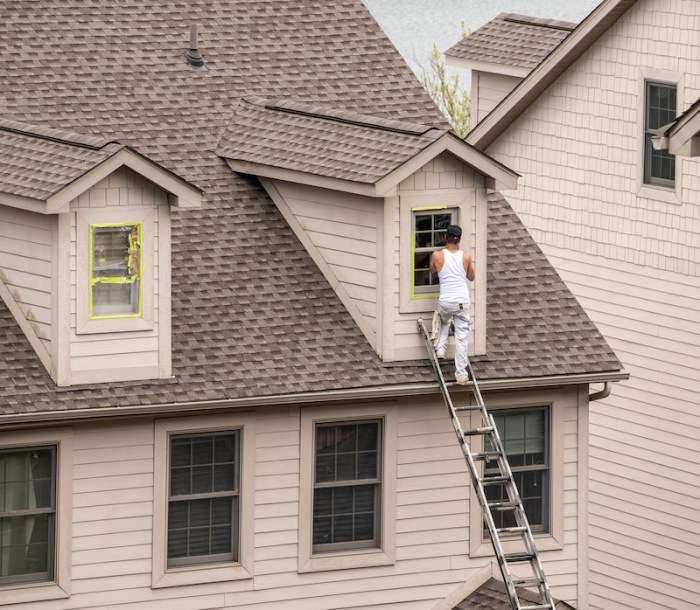
Source: myfourandmore.com
In conclusion, this DIY exterior renovation guide has provided a robust framework for successfully managing your home improvement project. By understanding the planning stages, comparing costs, and implementing the safety protocols, you can navigate the complexities of any exterior renovation, from simple touch-ups to extensive remodeling. Remember to meticulously plan, prioritize safety, and manage your budget effectively. With this knowledge, you can confidently transform your home’s exterior, creating a space that reflects your personal style and meets your practical needs.
